
The week of Apollo 11’s fiftieth anniversary dovetailed perfectly with the launch of the 2020 Chevrolet C8 Corvette.
Coming 50 years after the lunar landing, General Motors celebrated NASA’s achievement, with astronauts on hand as ambassadors to remind the public that rockets at the rear had powered them to the moon. Without missing a beat, Corvette showed the world that rear engine placement is highly effective for not just astronauts, but also for American sports cars.

Corvette chief engineer Tadge Juechter told the audience of assembled media, dealers and Corvette owners: “Our mission was to develop a new sports car that combines all of the things we do really well today with the performance and driving experience of mid-engine supercars, all while meeting requirements from all around the globe, including right-hand drive markets.” Jaws hit floors across Australia.
That’s right, an all-new Corvette has finally been developed for us, and it will be here by late next year or early 2021. Right-hand drive models weren’t on display (this being an American event, after all), but Juechter reiterated that right-hook had been part of the new car’s plan from the beginning.
The iconic American sports car has a reputation for supercar performance at a fraction of the price of a European exotic. This eighth-generation model marks a major turning point with this, the first production mid-engined Corvette.
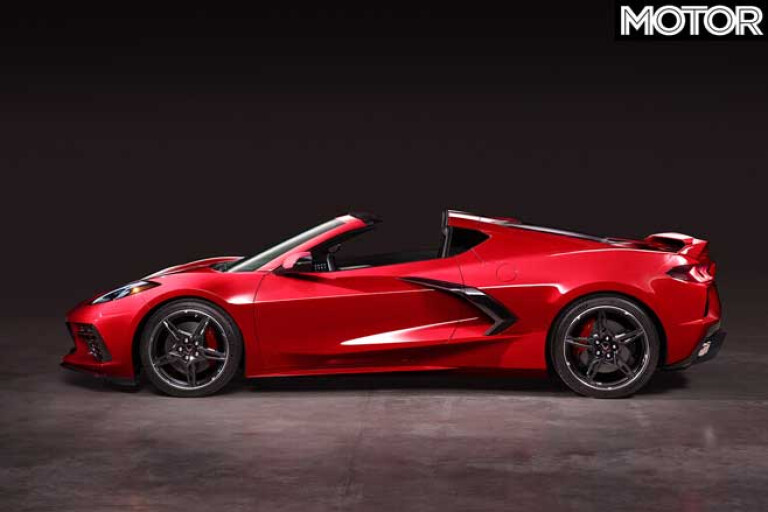
Visually, it has all of the Corvette hallmarks, with a striking, angular design and athletic proportions. The long bonnet has been replaced by a short, aggressive nose, and the cabin is now set forward.
Mid-engined sports cars are revered for their optimal weight distribution and effective dynamics, offering better handling, braking and acceleration than a front-engine/rear-drive configuration. They’ve been causing a stir since Sir Jack won the 1957 Formula 1 World Championship in a Cooper.
Rumour suggests the Corvette engineers had hoped to develop the previous C7 as a mid-engined car, but GM at the time was entangled in bankruptcy, government bailouts and a subsequent reorganisation. As such, the Corvette’s life as a front-engined car was extended, and the platform taken to the extremes, including the 485kW Z06 and the all-conquering ZR1 with its 563kW supercharged V8.

The C8 is an all-new Corvette in nearly every way. It retains only the good stuff from the C7. Carried over are some of the components of the naturally aspirated 6.2-litre LT1 V8 base engine, now dry-sumped for improved lubrication during the high G-loads often encountered by sports cars.
The new LT2 in the C8 uses the LT1’s proven valvetrain, pistons, connecting rods and forged crank. It makes peak power – a healthy 369kW – at 6450rpm and peak torque of 637Nm arrives at 5150rpm, which makes it an unusual powerplant for 2020. Where competitors shine with torque curves that resemble the venerable shape of Uluru by way of small displacements and clever turbocharging, Corvette has gone about making power the old-fashioned way.
With peak power near the top of the rev range, this naturally aspirated V8 needs to rev and, by its nature, will reward drivers willing to explore the LT2's entire bandwidth. Maximum revs are limited to 6600rpm, just like the old LT1.
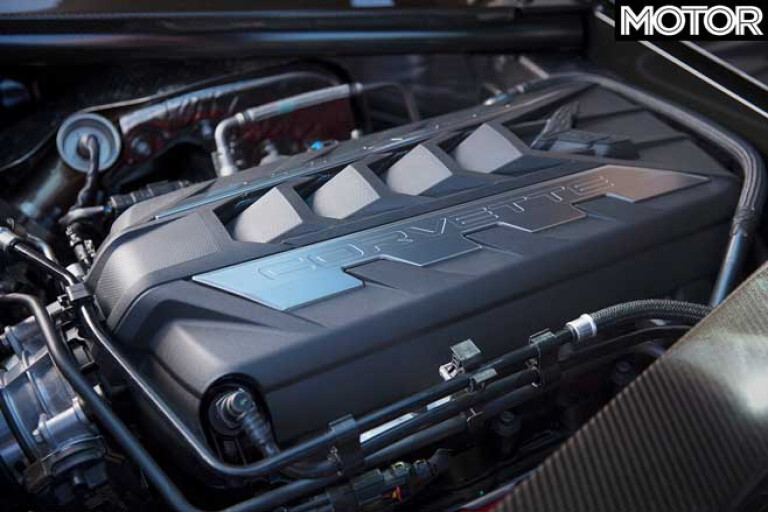
Thanks to the dry-sump design, the LT2 sits extremely low in the chassis. So low, in fact, that looking under the engine cover is like peering down a deep well. The placement of an Audi R8’s V10 is ostentatious by comparison.
There is only one transmission available, a Tremec-supplied eight-speed dual-clutch unit. Practical considerations eliminated the notion of a manual, Juechter explaining that the new car’s layout made it effectively impossible to ensure acceptable ergonomics with a three-pedal set-up.
There’s no question the DCT shifts quicker than any manual and contributes to the Corvette’s quoted 0-96km/h time of “under three seconds”.
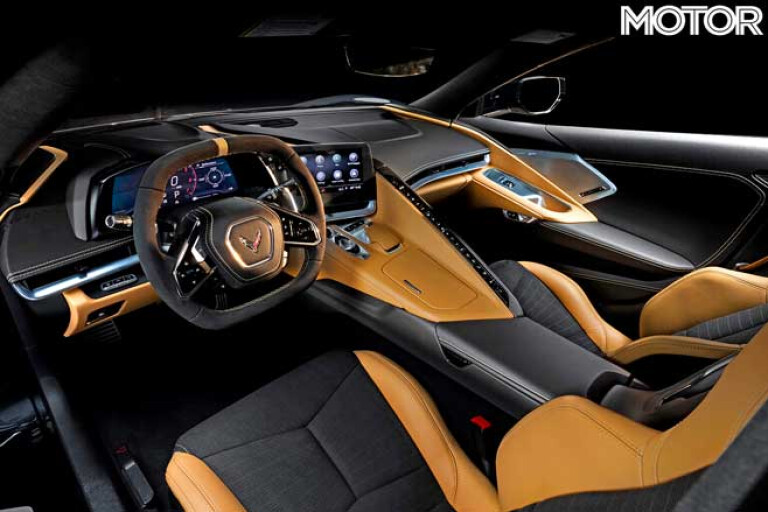
Moving the cabin 42cm forward in the chassis puts the driver’s feet near the front wheels, which now encroach into the footwells. So no room for a clutch and footrest, putting the final nail in the manual’s coffin.
The shift paddles are wired directly to the gearbox, which eliminates any signal lag that could otherwise occur had those signals been run through the Corvette’s electronic architecture.
For optimal weight distribution, the gearbox and the electronically controlled limited-slip differential sit behind the engine. GM has been using these e-diffs in many of their performance vehicles and they’re often the unsung heroes of corner-exit acceleration.
Unlike a mechanical LSD, these modern diffs can vary lock-up from zero to 100 per cent, but that’s not the real story. Under acceleration, lock-up is almost instantaneously determined by a range of parameters and varies as conditions change. But it has another ace up its sleeve. For stability and driver confidence, an e-diff can instantly switch to fully open under braking.
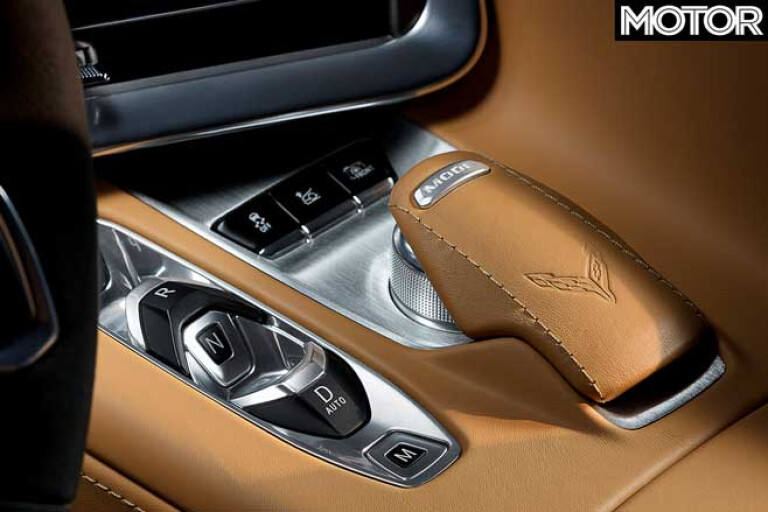
The single option that makes this new Corvette a little quicker is the desirable Z51 package. This has long been the choice for track-day drivers and is also required if you plan to attempt those sub-three-second sprints. For C8, the Z51 package includes a mild front splitter, taller rear wing, more aggressive suspension settings with adjustable spring perches, optional magnetic-ride dampers, more effective cooling, throatier exhaust and a lower final-drive ratio.
The new chassis is based around six large aluminium castings, enabling a signature Corvette feature to be retained – a removable targa top.
Since the C7, all Corvette coupes have been fitted with a targa roof panel to enable open-air motoring while maintaining the convenience and security of a hardtop. The C7’s top could be conveniently and easily stowed under the hatch, with some cargo space to spare.
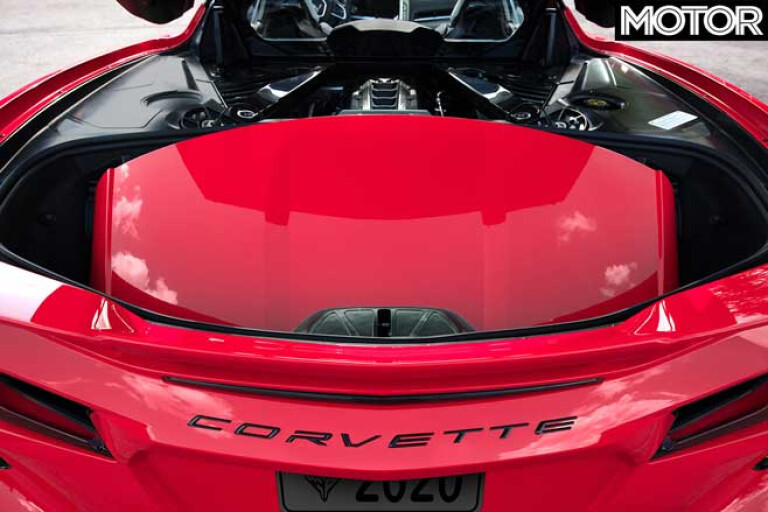
Storage in the C8 is comprised of a boot in front and one in back. There’s more than enough space in the front for a single piece of carry-on luggage and a small backpack. Rear storage is a deep well that’s large enough to carry two full-size golf bags, one atop the other. On the other hand, the targa top stows vertically in the rear trunk, subsequently eliminating any cargo-carrying utility back there.
Without a tall V8 under the bonnet, the cowl height has been lowered, and the driver is faced with a generous view of the road. From the driver’s seat, the cabin feels spacious, and the large window openings add to the expansive feel.
A further benefit of the mid-engine layout is a vastly improved steering system. By design, the steering column is shorter, which should lend more direct steering feel, and at the same time the steering ratio has been quickened by three per cent.

Corvette has long been known for its use of rear leaf springs, but the C8’s suspension is thoroughly modern. Each corner has double wishbones and coilovers. A front-axle lift system is fitted as standard, but with this Corvette it’s GPS-enabled, automatically lifting the nose at your regular driveways and speed humps.
Perhaps inspired by the Corvette C7.R Le Mans racer, the steering wheel is a two-spoke design that’s squared-off both top and bottom, forming more of an oblong shape.
The wheel includes a top centre mark, helpful for track work or those unintended skids, and a handful of buttons. There is also the signature ‘Z’ button – its name taken from the Z06 and ZR1 – that works much like the ‘M’ and ‘N’ buttons found in BMW M sports cars and Hyundai N hot hatches. With a quick press of the Z button, the Corvette can instantly switch to preferred individual drive-mode settings.
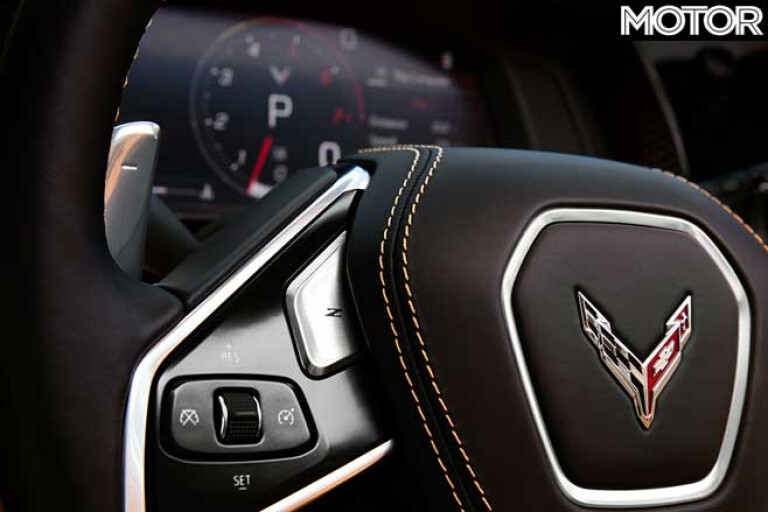
The driver sits low in the chassis, and another benefit of the C8’s aluminium construction is a low sill height, making getting in and out of the cabin as easy as possible. Three different seat styles are available, from mild to aggressive in terms of style/comfort, and the interior colours and patterns are both modern and attractive.
Facing the driver is a 30cm digital instrument cluster that can be configured to suit individual tastes. Atop the centre of the dash is a 25cm infotainment screen and, like the rest of the cockpit, it’s also angled slightly in favour of the driver.
By the numbers, the Corvette has a 2722mm wheelbase, measures 4630mm long and 1834mm wide. By comparison, the current Porsche Cayman is shorter by 25cm in both wheelbase and length, and is 13cm narrower.

According to GM, the C8 tips the scales at 1530kg dry. We estimate the official kerb weight will be closer to 1630kg, which is 134kg more than the C7. Some of that additional mass is undoubtedly derived from the front-mounted radiators and associated cooling lines that run through the chassis.
This is one sports car that is unjustly treated by the camera. In person, its proportions are right, and its street presence is clear – this is an unadulterated American sports car prodigy. It’s Corvette for the modern age.

2020 CHEVROLET CORVETTE C8 SPECS
Engine: 6162cc V8, SOHC, 16v
Power: 369kW @ 6450rpm
Torque: 637Nm @ 5150rpm
Weight: 1630kg (est)
Transmission: 8-speed dual-clutch
Price: $175,000 (est)
Meet the new LT2 V8
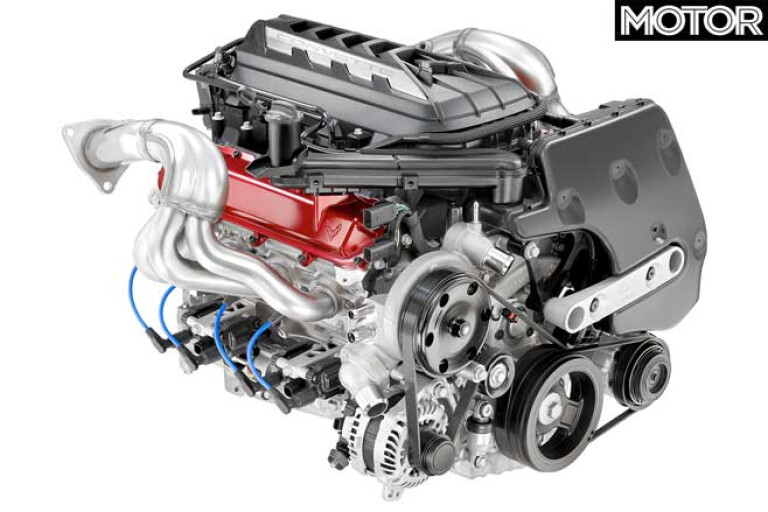
The Corvette’s new, all-aluminium LT2 small-block pushrod V8 is based on the existing LT1. These two engines share the same bore, stroke, forged crankshaft, connecting rods, pistons and valvetrain. As such, they have the same rev limit of 6600rpm.
Fundamentally, the LT2 differs from the LT1 with a revised camshaft and, most importantly, a dry-sump engine lubrication system. The dry sump eliminates the need for a traditional oil pan and allows the engine to be mounted 25mm lower in the chassis. There are three scavenge pumps, one fixed in the centre of the V and two in the crankcase.
In the past, dry-sump lubrication was reserved for high-performance Corvette models, but is now standard in the base model. The main benefit to a dry sump is that it maintains engine lubrication during sustained, high G-load conditions – those you will experience while enjoying your Corvette at a track day, for example. Further benefits include less crankshaft drag in the crankcase and a reduction in oil capacity from 9.2 to 7.1 litres.
The C8's VE mule

General Motors began developing the C8 Corvette shortly after the C7 was launched in 2014. They were faced with an important challenge – not only developing the mid-engine car but also keeping it under wraps.
Without a suitable modern mid-engine chassis available for development, they built one. Then they chose to disguise their earliest mid-engine mule as a Holden VE ute. Given the lack of utes in America, this seemed the perfect disguise for development and testing.
They paired an existing small-block V8 to an adapted Porsche PDK transmission, fabricated the rest of the car around the drivetrain, and tacked on the front end of a Holden. They called it Blackjack.
This ute-mutant looked like it could have cast for a role in the latest Mad Max film. It was a completely unconventional vehicle and didn’t resemble other GM products. The front guards of the Holden bodywork were widened and it had what appeared to be the bed of a ute, but with an unusually tall, fixed spoiler tacked on.
Despite GM’s best efforts to keep it hidden, the test car was captured by spy photographers early in the development cycle, which led to speculation in 2015 that Blackjack was indeed a mid-engine Corvette mule.

COMMENTS